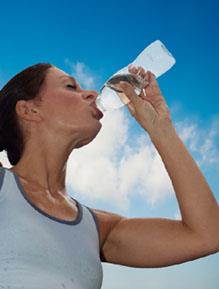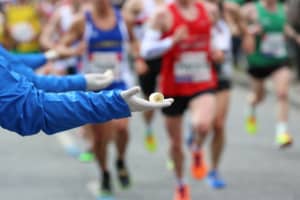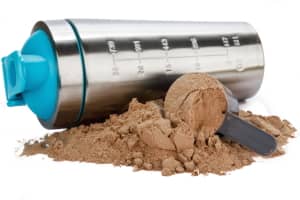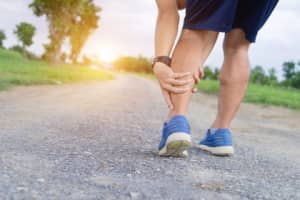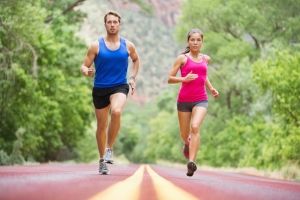The importance of good hydration
Hydration is crucial in any endurance activity. Poor hydration leads inevitably to poor performances and can cause tendinitis and other health problems. The endurance athlete must drink on a regular basis before, during and after exercise.
Our daily expenses in water
A sedentary adult loses between 2 and 3 liters of water per day. Elimination occurs through urine (1 to 1.5 liters), breathing (300 to 600 ml), sweating at rest (400 to 1000 ml), tears and stool (50 to 200 ml). These losses are compensated half by food and half by water absorption. When doing sport, sweating is the biggest source of water loss. It represents up to several liters per hour! Under these conditions, hydration becomes vital.
Risks of dehydration
In case of dehydration, the volume of water contained in blood plasma decreases, making the blood thicker. It takes the heart more efforts to propel it through the vessels. As blood circulation in small capillaries becomes more difficult, the oxygen and nutrients rate supplying the muscle decreases along with its ability to eliminate toxins. This decrease in blood volume will furthermore require the heart to beat faster to maintain blood pressure.
Under these conditions, performance will decline: a loss of 1% of body weight in water implies a decrease of 10% of physical abilities!
Water is acting as a lubricant to tendons and contributes to the elimination of nitrogenous waste. Depletion can cause tendinitis.
Kidney stones can also appear following the reduction of irrigation of the kidney.
Last, the athlete's hydration helps cool down the body during an effort. If this function is no longer ensured, a thermal shock can occur: the heat stroke.
Avoid heat stroke
Heat represents about 80% of the energy spent in an athletic effort. Perspiration helps the body cool down. This process requires large quantities of water. Severe dehydration can lead to overheating, a bit like an engine deprived from coolant. This is commonly called heat stroke.
High temperatures, high humidity, a lack of ventilation, a lack of water, vigorous activity in the hot sun can cause heat stroke. During heat stroke the body temperature rises and exceeds a critical threshold. This leads to headaches, fast heartbeat, a drop in blood pressure. Heat stroke is a serious issue that can lead to neurological sequels or even death. It must be treated immediately.
To prevent heat stroke, drink plenty of water, avoid workouts by high temperatures, splash water when climbing passes, keep your shirt wide open, prefer shaded routes, stop immediately in case of heat disease symptoms (headache, goose bumps, nausea, dizziness).
In case of heat stroke, immediately seek for medical or first aid. While waiting for their arrival, hydrate the victim to reduce their body temperature. Place them in the shade, open or remove their shirt, immerse them in cold water or, failing that, spray them with water, make them drink. In case of unconsciousness, place the person in the recovery position.
Signs of dehydration
Signs of dehydration are mainly:
- Thirst
- Increased heart rate
- A drop in blood pressure
- A drop in performance (fatigue, breathlessness, heaviness in the legs, tendinitis, ligament and muscle aches)
When these signs appear during a major athletic effort, it is already too late to take action. The absorptive capacity of the stomach being insufficient to catch up, dehydration is inevitable.
In practice
When to drink?
You must drink before, during and after exercise.
Drink the eve of the race until going to bed in order to remain well hydrated. An hour before exercise, drink a carbohydrate-based drink containing a low dose of sugar (20 g/l). Prefer fructose to sucrose to avoid hypoglycemia due to insulin production. We advise you to drnk an isonotic beverage (see how to prepare an isotonic drink).
When exercising, drink before feeling thirsty. The sensation of thirst indicates severe dehydration (20% of body needs) which will be impossible to catch up. Also note that our stomach cannot absorb more than 75 cl of liquid per hour. So drink regularly and in small quantities.
Hydrate after exercise and until bedtime.
What to drink?
After an hour of vigorous activity, pure water can cause hyponatremia (sodium deficiency). To avoid this problem while replenishing lost carbohydrates and electrolytes, buy or prepare isotonic drinks.
Prefer you drink cool, if possible, but never frozen. One drink too cold can disrupt digestion and cause intestinal upsets. 15 ° C is an ideal temperature.
Clothing
Wear light-coloured and loose-fitting clothing. Prefer jerseys with a full zip that can be opened completely in the climbs. Choose a helmet with good ventilation. Wear a cap under the helmet and spray it with water. A bandana can be useful for absorbing perspiration from the head.
Other tips
- Always take with you a bottle of water that you can spray on you when climbing a pass
- Schedule physical outdoors activities for the cooler parts of the day, especially for strenuous efforts
- Bring a sunscreen with you, especially if you go in the mountains! Moisturize your skin after showing
- Drink more in hot weather, strong wind and in the mountains where the air is drier
- Use a thermal flask to keep your drink at a suitable temperature.
On the edge between deficiency and excess
Drinking too much water can cause hyponatremia, i.e. overhydration of cells that leads to the dissolution of sodium in the blood. This condition can cause physical symptoms such as nausea, distaste for water, vomiting, lethargy, disorientation and even seizures, respiratory distress, loss of consciousness or even death.
These articles may also interest you
Sports nutrition: easily create your own 100% personalized food program
The 5 best food supplements to improve sports recovery
Running: 10 mistakes to avoid when starting out
Photo credit : Adobe Stock. This article contains commercial links.

